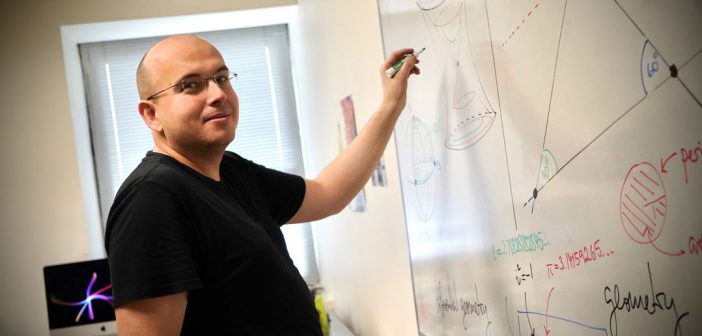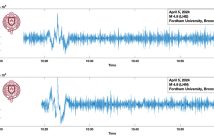Hein, a Princeton-educated mathematician who moved to the U.S. from his native Germany more than a decade ago, is the first Kim B. and Stephen E. Bepler Chair in Mathematics at Fordham University. Since his appointment last fall, he’s had more time to pursue his research in differential geometry, or geometry in any dimension.
On a daily basis, he develops methods and equations that lead to new shapes. These shapes can surpass three-dimensional space. It’s impossible to sketch some of them. But the point of his papers, often with titles as abstract as “A Liouville Theorem for the Complex Monge-Ampere Equation on Product Manifolds,” is to explore uncharted territory in the realm of mathematics and develop new ways of thinking that can describe complex phenomena like black holes, though perhaps only decades or centuries from now.
“[Mathematicians] try to figure out patterns, describe certain things that they observe, purely within math,” Hein said. “These methods and equations have a life of their own. They exist abstractly, without any specific application. And then 20, 30, 50 years later, it may turn out that this is exactly the right kind of math that you need to describe something that actually exists in the real world—like gravitational waves or black holes.”
How did your love for math begin?
There used to be these TV programs in Germany for people who didn’t finish high school or wanted to brush up on high school material before they went to college. I started watching the trigonometry program, just out of curiosity, when I was 9 or 10. I liked the shapes. They were explaining how to graph sin and cosine. I sat down after the lesson and tried to recreate that on paper on my own. And I got a shape that looked like the thing that I saw on TV.
How do you define mathematics?
Simple ideas that solve problems, that, in the end, are correct. It doesn’t depend on anybody’s opinion. It’s some pattern or idea that’s going to be correct a thousand years from now, if humanity still exists.
Your branch of math is differential geometry. What does that mean?
There’s the more elementary stuff, like basic differential geometry that actually happens in three-dimensional space, that actually exists in the real world, that engineers and physicists use all the time. Then there’s my work—the rarified, cutting-edge stuff in theoretical math.
What does it look like for you to do research? It’s obvious for chemists and biologists. They have microscopes, petri dishes, beakers—things like that. But for you, a mathematician, how does that work?
I lie on the couch all day. I imagine shapes and connections between shapes and quantities and try to figure out if some quantity is going to be large or small—how different quantities interact with each other. It’s a little bit like art in the sense that you create shapes and patterns. And then if I have the complete picture in my mind, I’m usually able to see the solution.
My wife is a mathematician, too, so at least it’s not weird for her. She knows what’s going on … that I’m actually working.
When you’re brainstorming, do you map out your thoughts on a blackboard?
No. It’s just in my head. If I’ve really thought something through, I can just go to my laptop and write like 10 pages of equations and formulas and arguments and reasoning, based on what I have been imagining. Sometimes I have to do some calculations on paper, but that usually comes later.
What’s the most difficult part of your research?
That you’re stuck constantly. You don’t know what you’re doing most of the time. It’s not like you’re applying some method that you learned in grad school, and you’re trying to use that to create something new. I mean, sometimes it’s like that. But more often, you’re working on some problem that nobody’s really thought about before—that certainly no one has ever solved before. What that usually means is that the methods that exist aren’t sufficient enough to solve that problem.
So you have to come up with new methods?
Right. Usually it’s a tweak on some method that you learned in grad school or from somebody else’s paper. But, you know, once in a while, you have to create something completely new.
To a non-mathematician, how do you explain the importance of your work?
This kind of math that I do is incredibly abstract. Right now, nobody knows if it’s ever going to have an application to anything real. Much of the math is developed completely independently of any applications to physics [for example]. We often create new ideas for their own sake. And then [decades or even centuries later]it turns out to be exactly the right math that’s needed to make sense of things like quantum mechanics.
You discover these new beasts, specimens. You can see them in your head. Somehow, they’re out there.
This interview has been edited and condensed for clarity.



